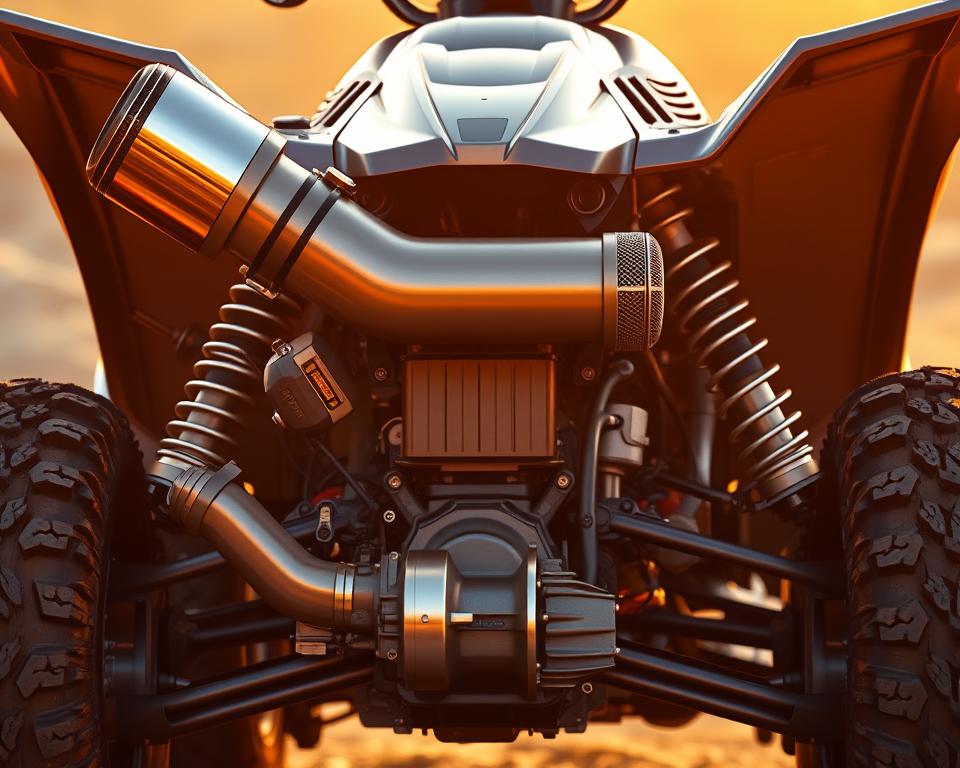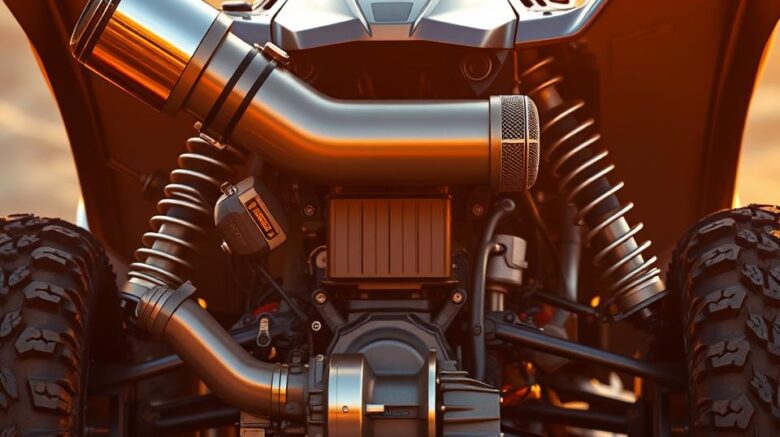How New Riders Can Avoid ATV/UTV Gear Selection Pitfalls
Have you heard that nearly 20% of new ATV and UTV owners face gear selection issues within their first year? That figure highlights why beginners need to understand ATV gear ratios. Correct gear choice protects against accidents as well as enhances power. Let’s dive into gearing missteps, care routines, and top UTV accessories store tips to enhance your rides.
Principal Conclusions

- Understanding gear ratios is vital for optimal ATV/UTV performance.
- Typical gear mistakes compromise safety on uneven ground.
- Routine care averts transmission breakdowns.
- Choosing the right gear boosts trail enjoyment.
- Following upkeep advice extends your ATV’s life.
Understanding ATV and UTV Gear Ratios
ATV/UTV gear ratios dictate how power meets torque. They dictate how engine power translates into speed and torque. This controls how quickly you get up to speed and tow trailers. By picking specific ratios, you tailor your ride for drag, trail, or work.
Picking the correct ratio optimizes power delivery. Too low a ratio may leave you underpowered on inclines. Conversely, too high a ratio hampers quick takeoffs on flats.
Many enthusiasts use gear reduction to enhance handling and adaptability across different terrains. By adjusting gear ratios, riders can customize their vehicle’s performance. It lets you balance acceleration with pulling force. Optimal ratios deliver smoother use and better MPG.
Common Gearing Oversights for New ATV/UTV Owners
Correct gearing secures top output and trail safety. Rookies often miss key selection factors. Knowing what happens when you misgear and how to fix it transforms your experience. It also helps avoid issues.
Impact of Incorrect Gear Selection
Misgearing risks crashes and costly damage. Poor gear choice dampens speed, stresses brakes, and accelerates wear. These mistakes can significantly reduce riding safety, posing risks to the rider, passengers, and others nearby. Following key ATV maintenance tips can help avoid these issues.
Choosing the Right Gear for Terrain
Different terrains need different gearing for efficient performance. Climbing requires low-end grunt from smaller ratios. On flat terrains, higher gears help increase speed. In muddy or sandy conditions, choosing the right gear is essential for traction and stability. Understanding trail types secures fun and safety.
The Importance of Proper ATV Maintenance
Routine upkeep ensures reliable performance. Following ATV maintenance tips helps avoid unexpected breakdowns and boosts safety. A tailored service plan prioritizes drivetrain care.
Regular Inspection and Maintenance
Using a checklist uncovers faults before they escalate. Routinely examine gearbox teeth, brake pads, rubber, and belts. Integrating inspections into your schedule boosts reliability. Here are some critical inspection points to remember:
- Inspect gearbox alignment and pitting.
- Check for loose bolts or connections.
- Inspect brake lines and levels.
- Verify tire PSI and rubber life.
- Inspect battery terminals and cables for buildup.
Fluid Changes and Gear Health
Fluid quality is critical for UTV drivetrain maintenance. Regularly changing engine oil, gear oil, and coolant prevents grime buildup. Pure coolant and oil lower temperatures and prolong service intervals. Using this method secures dependable function and fewer breakdowns.
| Fluid Type | Recommended Change Interval | Benefits of Regular Change |
|---|---|---|
| Engine Oil | 50–100 operating hours | Reduces engine wear, enhances performance |
| Differential Oil | 100–200 operating hours | Smooths shifts and prevents pitting |
| Coolant | Once per year | Stops boil-overs and freezes |
Sticking to this plan ensures uninterrupted trail fun. That boosts confidence and enjoyment.
Common ATV Gear Shifting Problems
Many beginners wrestle with the gearbox. Mastering smooth shifting techniques can greatly improve the riding experience. It reduces frustration on the trails. Proper coordination of the throttle and clutch is key for control and avoiding shifting problems.
Learning to Shift Smoothly
Honing silky shift skills takes deliberate training. Start by getting to know your ATV engine’s rhythm. Gentle shifts spare your gearbox and extend service life. Timing your throttle input when releasing the clutch is critical.
Practice shifting in a controlled setting until you’re confident. Focus on gentle throttle application during each gear change.
Recognizing Signs of Gear Issues
Early detection of gear issues is essential. Watch for whines, clanks, or crunches in the gearbox. Hard shifts or missed gears indicate trouble. Fixing problems fast keeps you safer on the trail. Resolving shift issues preserves power delivery and morale.
Understanding UTV Transmission Issues
Transmission headaches are common; understanding them aids fixes. Owners often face issues like slipping gears or odd noises. Below we break down common failures and the tools to troubleshoot them. Leveraging user-friendly diagnostic procedures.
Diagnosing Common Problems
Noticing early clues saves you from expensive repairs. Common issues include:
- Unexpected gear drops that compromise handling.
- Strange noises signaling internal wear.
- Signs of fluid seepage that threaten gearbox health.
Regular gear diagnostics help spot these issues quickly. This allows for prompt action. Missing early clues damages your ride and wallet.
Solutions for Troubleshooting UTV Transmissions
Repairing gearbox problems calls for methodical steps. Follow these steps for effective troubleshooting:
- Verify oil levels and refill as needed.
- Examine for any leaks under the vehicle.
- Inspect the gearbox for wear or damage.
- Test drive the UTV at various speeds to monitor gear engagement and responsiveness.
- Reference factory troubleshooting charts for your UTV.
Leveraging a proven guide speeds up repairs. Grasping drivetrain theory helps maintain your rig. That insight preserves reliability and output.
ATV Clutch Adjustments and Their Benefits
Accurate clutch tuning unlocks seamless shifts. Misadjusted clutches cause jerky shifts and rider irritation. Routine calibration refines clutch response and engagement.
Precision in gear changes is critical. Correctly calibrated clutches enable flawless transitions. It refines acceleration and comfort across all conditions.
Neglecting clutch upkeep accelerates wear and reduces power. Regular tuning keeps shifts sharp and the motor lively. Every operator should prioritize clutch checks for optimal use.
Mastering the Art of Gear Shifting
Excelling at transitions elevates your trail adventures. It requires knowledge of your vehicle’s mechanics and developing a keen sense of timing and spatial awareness. Beginners should focus on the rhythm of shifting gears. A comfortable cadence leads to smoother transitions and improved performance.
Proficient gear shifting demands practice, across various riding conditions. Knowing shift points for hills, flats, and mud secures handling. For instance, shifting down when approaching a steep hill helps maintain power and stability.
- Practice shifting at low speeds to build confidence.
- Listen and feel each gear engagement.
- Step up to steeper, rougher trails as you improve.
Getting in sync with your ride ensures perfect shifts. Listen for pitch changes and shudders to guide engagements. This helps determine the optimal moments to shift. Such intuitive understanding leads to proficient gear shifting, making your ride more enjoyable.
Best Practices for UTV Gear Selector Problems
Tackling selector issues calls for scheduled checks and troubleshooting. Regular inspections are key to spotting issues early. Learning proper lever use minimizes failures. Routine checks should include visual inspections of the selector linkage and fluid levels, which are vital for performance.
If you suspect a fault, inspect the lever assembly for bends or breaks. Unusual noises can also hint at problems. Minor tweaks typically fix selector snags. An organized maintenance schedule helps manage wear and tear.
Tracking shift quality across terrains isolates faults. Applying these tips secures selector durability and trail confidence.
Tips for Enhancing Gear Performance
Sustaining peak gear health involves systematic care. Regular maintenance is key to improving ATV efficiency. Monitor fluids, look for damage, and fine-tune as required. Catching nicks before they worsen saves you big bucks.
Picking ideal ratios unlocks quicker revs and seamless cruisin’. Understanding the terrain you will face allows you to select the appropriate ratios. This decision impacts everything from acceleration to top speed. Seeking parts from specialists such as American Off-Roads aids in UTV performance enhancements.
Implementing gear performance tips in wheels, springs, and ballast optimization elevates function. These tweaks guarantee superior handling in rough conditions. This leads to a more enjoyable riding experience. These steps ensure fearless exploration and maximum excitement on the trail.
Bringing It All Together
Nailing gear selection unlocks peak power and protection. Knowing how to choose the right gear for different terrains greatly improves your ride. By avoiding common mistakes and making smart choices, your off-road trips will be both fun and secure.
The importance of performance maintenance cannot be overstated. Scheduled maintenance and TLC save you from breakdowns and prolong service. Adequate maintenance enhances function and safeguards adventures across any terrain.
Combining correct gearing with scheduled service delivers peak satisfaction for riders. Embracing these tips sets the stage for countless epic journeys.
FAQ
Standard gear ratios on off-road rigs?
Ratio specs differ greatly by manufacturer and use case. Typical ratios lie within the 3-to-5 range. Smaller ratios deliver grunt for trails and climbs. Taller ratios boost runway speed on level ground.
Signs of misgearing for different surfaces?
Misgearing risks unstable handling, rev overload, or sluggish starts. Different grounds need dedicated ratios to maintain traction and speed.
How to know when your machine needs service?
Pay attention to hard shifts, strange sounds, leaky fluid, or waning torque. Periodic drive train reviews ward off costly repairs.
How often should I change the fluids in my ATV/UTV gear system?
Change the gear fluids every 1,500 to 2,500 miles, or at least once a year, depending on usage and terrain. Clean fluids ensure efficient gear operation and extend drivetrain life.
How to shift gears without jerking?
Master the throttle-clutch dance for silky shifts. Feather the clutch up while winding the throttle for a perfect match.
Steps to diagnose gearbox problems?
Begin with fluid level checks and a listen for whines or grinds. Inspect the transmission fluid level and condition. Then, perform a basic diagnostic to identify any mechanical failures.
What is the importance of clutch adjustments in an ATV?
Well-set clutches ensure crisp gear changes. An improperly set clutch can cause shifting difficulties and may lead to premature wear on transmission components.
How can I improve my gear performance on different terrains?
Experiment with various gear ratios and consider aftermarket modifications from reputable brands like American Off-Roads. Regular maintenance, such as checking gear health and fluid levels, also enhances performance.
Addressing a bad gear selector?
Scheduled upkeep resolves most shifter faults. For jams or mis-engagements, follow your manual’s diagnostic steps.
What common mistakes should new ATV/UTV owners avoid?
Rookies tend to ignore ratio basics, delay upkeep, or misgear for mud, rock, or hills. Such errors cause subpar power delivery and increased accident risk.
